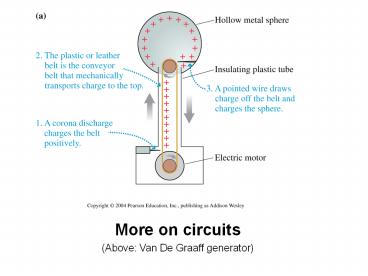More on circuits - PowerPoint PPT Presentation
Title:
More on circuits
Description:
More on circuits (Above: Van De Graaff generator) More on circuits: review Series resistors: a) the current flowing through each resistor is the same as the total ... – PowerPoint PPT presentation
Number of Views:199
Avg rating:3.0/5.0
Title: More on circuits
1
- More on circuits
- (Above Van De Graaff generator)
2
More on circuits review
- Series resistors a) the current flowing through
each resistor is the same as the total current
drawn from the battery b) the potential
differences across the resistors add and the sum
is equal to the battery voltage. - The equivalent resistance of the circuit
I
3
Parallel resistors
- a) The potential difference across each resistor
is the same b) the currents flowing through each
branch must add up to yield the total current
drawn from the battery. - Equivalent resistance
4
Q1
- As more resistors R are added to a series
circuit, the current drawn from the battery - 1. increases.
- 2. remains the same.
- 3. decreases.
5
Q2
The equivalent resistance for a group of parallel
resistors is
1. less than any resistor in the group. 2. equal
to the smallest resistance in the group. 3. equal
to the average resistance of the group. 4. equal
to the largest resistance in the group. 5. larger
than any resistor in the group.
6
Q3
- As more resistors R are added to a parallel
circuit, the total current drawn from the battery - 1. increases.
- 2. remains the same.
- 3. decreases.
7
Terminal Voltage
- Ideal battery e is the work is done by an
electrochemical reaction in order to separate
charges. - Terminal voltage DVab lt e due to
internal resistance Ri in real batteries. - The internal resistance is in series with the
load resistance R, i.e., the resistance of the
external electric circuit.
8
Q4
- A light bulb having a resistance R is
connected to a battery. If the light bulb is
replaced with another light bulb having a larger
resistance, the terminal voltage DVab of the
battery - 1. increases with increasing R
- 2. decreases with increasing R
- 3. remains the same.
9
Q5
- When you connect a light bulb to a battery and a
current flows through the circuit, which is true? - Electric energy is conserved.
- Total energy is conserved.
- Charges are absorbed in the thin wire inside the
bulb causing the wire to glow. - All of the electric energy is transformed into
light. - All statements above are true.
- All statements are above false.
10
Electrical Power
- P DV I
- Unit Watt (W) V A
- kW, MW, GW
- In circuits, charges do work on light bulbs,
appliances, etc. and electric energy is
transformed into other forms of energy (food
blender example).
11
Q6
Rank in order, from largest to smallest, the
powers Pa to Pd dissipated in resistors a to d.
- 1. Pb gt Pa Pc Pd
- 2. Pb Pc gt Pa gt Pc
- 3. Pb Pd gt Pa gt Pc
- 4. Pb gt Pc gt Pa gt Pd
- 5. Pb gt Pd gt Pa gt Pc
12
Electrical Energy Dissipation
- Is the energy that is lost as heat (due to
resistance) every second. - Power P I DV (in general)
- using R DV/I, we obtain
- P I2 R or P DV2/R
- These equations apply only to the transfer of
electrical energy into thermal energy in a
resistive material Useful for light bulbs, space
heaters, computers, etc. - The equation P I DV applies to all kinds of
electrical energy transfer.
13
Q7
- If the four light bulbs in the figure are
identical, which circuit emits more light (more
power)? - 1) Circuit I 2) Circuit II 3) Both emit the
same amount of light.
14
Q8
Rank in order, from brightest to dimmest, the
identical bulbs A to D.
1. A B C D 2. A gt B gt C D 3. A gt C gt B
gt D 4. A gt C D gt B 5. C D gt B gt A
15
Short Circuits
- Sometimes faulty appliances can lead to short
circuits (often due to overheating, moisture
buildup on circuit boards, etc.) - Short circuit Positive and negative terminal
connected by very small resistance leading to
large currents. - Household wiring and can only handle current of
fixed amount 15A. Larger currents can damage
the wire. - (Nail burner demo)































